Relations between China and Korea
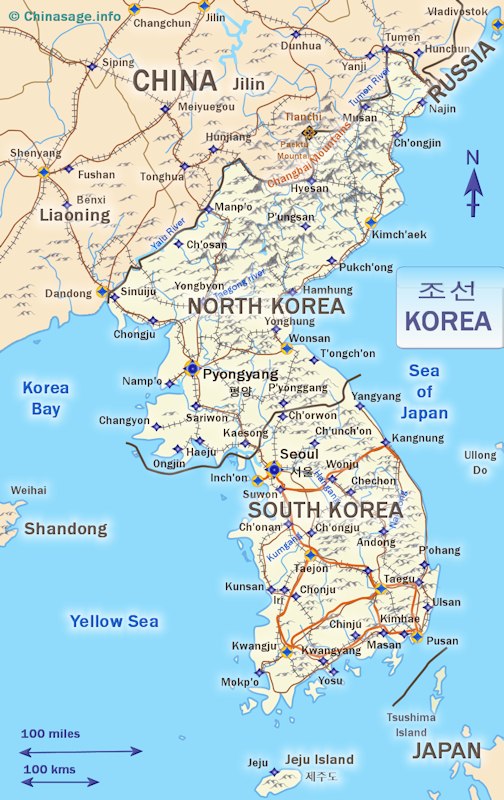
Korea forms a mountainous peninsula, the western coastline is part of the shallow Yellow Sea that forms an enclosed bay in northern China; while the mountainous eastern coast is close to the islands of Japan. Korea's position between continental China and Japan has strongly influenced its history from the earliest times. It has often been the victim of foreign involvement and to understand today's tensions over divided Korea it is necessary to follow history back to the earliest times.
NOTE: Our look at the country of Korea is only in the context of its relations with China. A full description of Korea is beyond the scope of this web site.
The natural northern border of the Korean peninsula with China is the Yalu River, but reflecting times of a larger Korean nation many millions of ethnic Koreans live on the Chinese side of the border in Liaoning and Jilin provinces. The northern border then heads into the Changbai mountains and passes through the impressive Tianchi lake. This is an ancient volcano (last erupting 1702) and is often used as the geographical emblem for North Korea. The crater lake is very deep and is believed to harbor a Loch Ness ➚ type monster.
The climate is generally cold and dry in the north but with summer rains in the south. Agriculture only allows for onions, cabbage, barley and buckwheat to be grown in the cold north. The northern mountains are rich in mineral deposits including gold, iron and coal. The peninsula is prone to both floods and famine. The country is densely populated and the Korean people are a distinct race (Korean-Manchu-Mongol group) with features distinguishing them from Chinese and Japanese people. Long contact with China culture has brought in considerable influence in areas of philosophy, government, ritual and religion. The Korean written language has strong roots in Chinese (hanja characters ➚) just like Japanese but the language is of independent origin. There are many loan words from Han Chinese with native Korean core characters. The root language is however independent – it is not in the Sino-Tibetan group of languages.
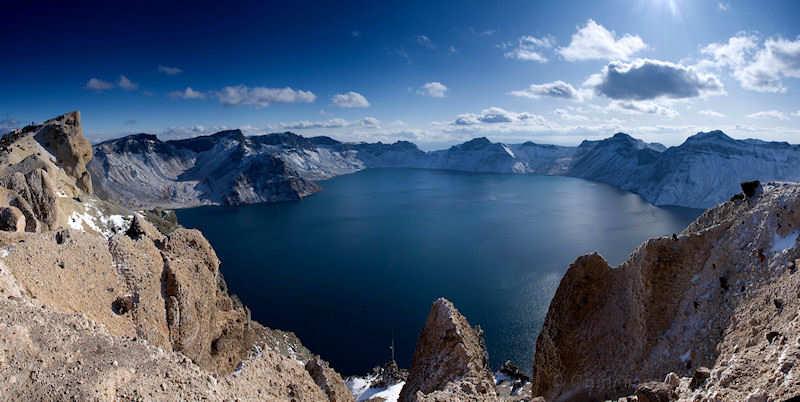

Early History
Archaeological excavation have shown a distinct Neolithic culture in Korea from about 3000BCE at Chul'mon with signs of very early agriculture and later at Mumun where rice agriculture had already started. Korea began making silk, and cultivating silkworms from about 1000BCE. In about 300BCE some Koreans moved to Japan and colonized it setting up the Yayoi culture ➚ there.
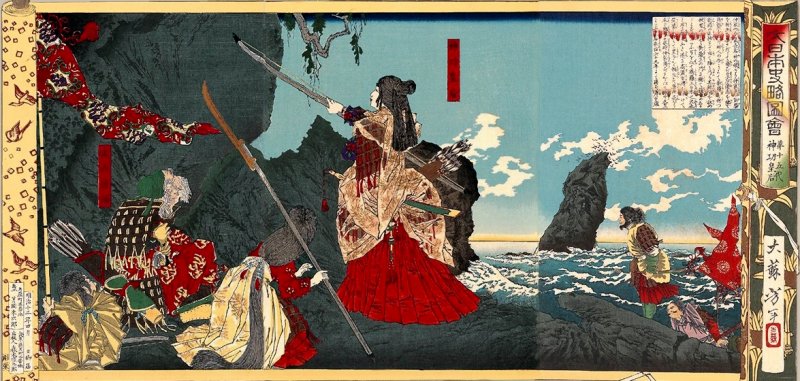
Chinese Han conquest
When Emperor Wudi founded the Han dynasty he soon set about expanding China's borders. In 108BCE northern Korea was integrated into Han as ‘Chaoxian’ and divided into four provinces together with parts of Manchuria. There are stone sculptures of Han style in Korea and extensive colonies of Han Chinese were founded that retained Chinese culture up until the 4th century before being gradually assimilated into the Korean population. The population of Korea grew substantially. The Chinese at Lolang (now called Pyongyang) numbered as many as 300,000 and the area was under Chinese control until 313CE. An excavation of the extensive Lolang necropolis ➚ produced fine Han bronze, lacquerware dating to 108BCE. During this period a considerable amount of Chinese culture was imported to Korea and then onwards to Japan.

Sui campaign
After the collapse of the Han dynasty Korea became independent again. For over four hundred years it was left alone until the Sui dynasty unified China. Sui Emperor Yangdi did not accept the independence of Goguoryo (a.k.a. Koguryo) (covering the rough area of north Korea and Liaoning) and began to meddle in Korean affairs with perennial fighting with the three kingdoms of Korea (Silla, Parkche and Goguoryo) during four campaigns 598-614 but all of these proved inconclusive as the Koreans were able to withstand long sieges within their heavily defended cities. The Chinese could only fight during spring - it was too cold in winter and the long supply chains proved ruinously expensive. The Sui Emperor became too preoccupied with the campaign in Korea to deal with flooding closer to home and the dynasty soon fell.
In the following Tang dynasty there was Korean resistance until 668 when Pyongyang was occupied by Tang forces. China backed the Silla kingdom against Parkche and Goguoryo ➚ kingdoms and in 688 there was a brief Korean unification in the Chinese style. The culture and institutions mirrored that of China for a long time thereafter; for example, by the ninth century tea drinking had become common in Korea. Buddhism became the main religion. After the Tang fell the Northern Song Liao kingdom controlled Korea and maintained extensive trade links with China as well as Japan.
Mongol control
In 1274 when the Mongols had subjugated the northern Chinese kingdoms of Jin and Liao there was a large scale attempt to invade Japan. Joint Korean and Mongol forces (25,000 Mongols and Koreans) made the attempt and failed. Later in 1281 a larger scale attempt (40,000 Mongols and Koreans, 100,000 Chinese) also failed. This is the time of the famous Kamikaze 'divine wind' that wrecked the huge Mongol navy and Japanese independence was retained.
Ming semi-independence
After the fall of the Mongols, the Ming dynasty took control of Korea as a vassal state. Paper money that had already been in widespread use in China now came to be used in Korea.
The Korean kingdom then founded the Joseon dynasty ➚ 1392-1897 and was known as the ‘Hermit Kingdom’ and from the Chinese characters for the dynasty : 朝鲜 Cháo xiǎn this became translated into English as ‘morning calm’ and so became known as the ‘The Land of the Morning Calm’. Korea's new found sense of independence moved it away from slavishly adopting Chinese culture, this was evident when in 1443 Korea adopted 24 phonetic letters (Hangul) to replace the Chinese script of thousands of characters.
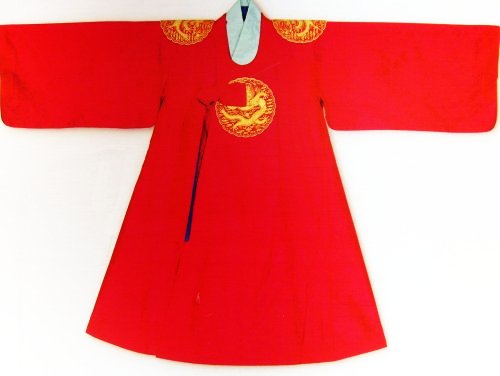
In 1592 Korea was invaded by a Japanese army of 200,000 which occupied Pusan, Seoul and Pyongyang. In January 1593 the Chinese counter-attacked over Yalu river and pushed back the Japanese. A Korean admiral developed turtle boats with curved tops to deflect missiles and managed to hold back the Japanese. However the large but ineffective Chinese army ground to a halt until the expansionist Japanese emperor died in 1596 and the invasion force left Korea.
The next conquest of Korea followed soon afterwards, the Manchu leader Abahai (1592-1643) conquered Korea in 1637 ahead of the later Manchu conquest of China. Korea remained a Manchu protectorate with the Joseon dynasty left to rule the kingdom. A period of of two hundred years of peace followed. The next conquests of Korea related to foreign powers beginning to exert power on China's outer fringes.

Japanese Threat
Britain as the only world super-power (1840-1920) wanted control of Yangzi valley but was somewhat over-stretched with campaigns and disputes in Sudan, Ethiopia and South Africa. Britain's policy of allowing free-for-all trade with China came under threat when France and Russia adopted policies of colonization in east Asia. As the UK had no spare forces to commit to northern China she funneled resources to her ally Japan to control Russian expansion into Manchuria and Korea.
In the period 1875-80 Japan was more or less in control of Korea (a treaty was signed in 1876). However a Japanese move to capture the Korean royal family was thwarted by Yuan Shikai in December 1884. However Chinese attempts to protect Korea did not stop further Japanese expansion, in 1894 Japan invaded Korea and China responded by attacking the Japanese force. In the first Sino-Japanese war ➚ 1894-5 China suffered a humiliating defeat, and this time by an Asiatic rather than European power. Japan, with British backing, then moved to invade Shandong. There was a battle between Russia and Japan to take northern Chinese territory. So as well as the whole of Korea, Japan took Taiwan, Shandong peninsula, Liaodong peninsula and the Pescadores islands ➚.
This Japanese land grab was opposed by three powerful European nations (Germany, Russia and France) and they intervened in the ‘Triple Intervention’ to force Japan to give back Liaodong peninsula (effectively to Russia not China). In all this confusion Korea became briefly ‘independent’ 1895-1910 but under strong Japanese influence.
On 8/2/1904 the Russo-Japanese War ➚ began when Port Arthur at tip of Liaodong peninsula was given to Russia. Japan as an ally of the UK (1902) retook Liaodong. This was because Britain wanted to stop Russia from gaining access to a seaport on the Yellow Sea. The US brokered a peace deal, and as a result in September 1905 gave Japan rights to develop Manchuria. But this deal did not hold for long, in 1910 Japan invaded Korea and ruled it as part of its expanding empire.
Second World War (1939-45)
During the war Korea remained firmly in the hands of Japan which now controlled neighboring Manchuria. Allied powers at the Cairo Conference ➚ failed to agree what to do with Korea on an Allied victory, a protectorate was considered under (the rather unlikely) joint trusteeship of the USSR and US. When Russia declared war on Japan in 1945 US quickly proposed the 38th parallel ➚ as a line of division of control. USSR rather surprisingly accept this division, the US side had not realized that back in 1910 this had been the suggested border between Russian and Japanese controlled Korea. The agreement gave the USSR access to warm water ports and firm control over Manchuria. There is no historical justification for dividing the country in this way, it is an arbitrary line on the map, drawn up without Korean agreement or even involvement.
With allied victory in 1945 the US was faced by Communist governments in China, Russia, north Korea and Mongolia all under the leadership of Russia. Its toehold of control in South Korea proved vulnerable.
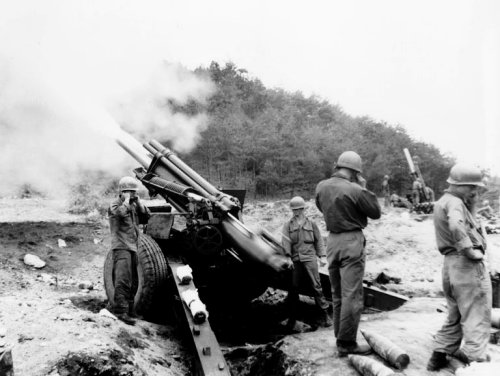
Korean War
The arbitrary division into North and South Korea, imposed by foreign powers far away was not accepted by the Korean people just like the division of Vietnam and Germany.
In June 1950 northern Korean forces invaded the south. The US received full UN backing to defend the south, so it was a combined US and UK Commonwealth force that moved into south Korea. The forces pushed the north Koreans back past the 38th Parallel and nearly to the border with China.
The flag of North Korea has a red star for communism, red panel for patriotism and blue stripe for unity.
China had legitimate fears that the forces would now advance north into Manchuria and China itself. US General MacArthur ➚ advocated unification of Korea and a possible attack on China, however Truman did not share this view and dismissed him, Truman also decided that nuclear weapons would not be used in this conflict. The USSR (Russia) would have been expected to have supported North Korea. It seems that there was no Russian appetite for a direct confrontation with the US and indeed Russia withheld air support for N. Korea at this crucial time.
The flag of South Korea has a central yin-yang figure surrounded by four trigrams (heaven, earth, fire and water). The white background represents the land.
Zhou Enlai warned that China would not allow its border to be threatened. China trained up 250,000 ‘Peoples Volunteers’ in secret (it could not risk the ‘official’ Chinese army becoming involved in a wider China-U.S. war) and on the night of 26th November 1950 they attacked the UN forces. By December 25th the combined N. Korean and Chinese force had crossed 38th parallel and captured the southern capital Seoul. The US was taken aback by this success against a modern highly trained army and this event probably prevented a wider war against China. Chinese General Peng Dehuai was then given control and the war became bogged down, the Chinese made huge losses (half the Chinese troops died including one of Mao's own sons) with little gain. By June 1951 the attacks had petered out and Russia suggested ceasefire talks with the 38th Parallel as the border. It took over two years to negotiate a full ceasefire while sporadic attacks rumbled on.
Aftermath
After the end of main hostilities, the Sino-Soviet split occurred making China the main player in North Korean politics. The 1950s and 60s was a period of Chinese isolationism there was a continuing fear of a Chiang Kaishek invasion backed by US forces.
With Kim Il-Sung ➚, a strong military leader, installed at Pyongyang, China felt that Korea was no longer a threat and China signed a pact with N. Korea to come to its aid if attacked. Tensions eased after the Nixon rapprochement of 1972 and China built friendly relations with S. Korea. With significant US aid South Korea prospered and became one of the Asian Tigers ➚ with an impressive economic boom. It has been finance from South Korean investors that has helped fuel Chinese economic growth particularly in Shandong province. An immense tunnel under the Yellow Sea ➚ from Korea to Shandong has been proposed as well as a tunnel ➚ to Japan. Substantial trade with N. Korea over the Yalu river has begun to build up. Chinese backed development in the Tumen Development Zone ➚ has encouraged investment in the border region.
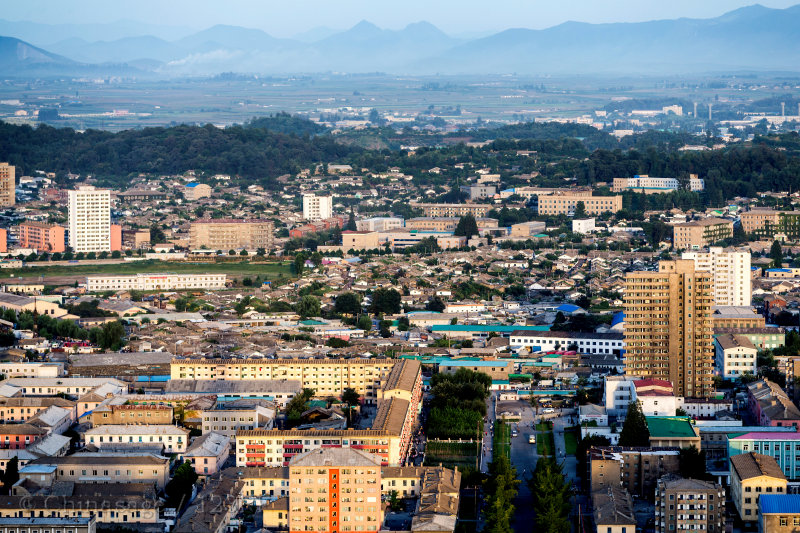
China and Korea today
China now has strong links with both North and South Korea, and an interest in seeing a peaceful and equitable settlement on her doorstep. A divided Korea is seen as the least worst option for China, as unification could bring a hostile US backed government to China's border. Although North Korea is an unhelpful neighbor with its nuclear ambitions and military dictatorship, China is seen as the one power that can exert pressure on President Kim Jong-Un. So China continues to be a somewhat unenthusiastic friend of North Korea hoping for reform but wanting it to remain independent from the South.
The real losers are the Korean people. After thousands of years of conflict and only very brief periods of self government they continue to be a pushed around by hostile foreign powers. It is hard to see how the present border that divides not just the land but families will remain in the long term, there is too strong a feeling of Korean national identity.